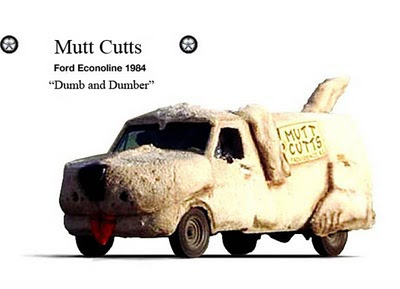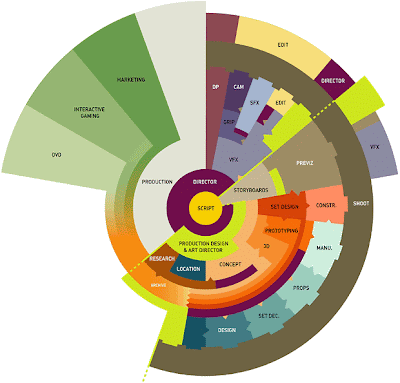Thursday, March 31, 2011
Wednesday, March 30, 2011
Visual Stories - War Horse
Film Maker Steven Spielberg is also making this story into a film version coming out at the end of 2011.

Friday, March 25, 2011
Wednesday, March 23, 2011
Incredible video of Aurora Borealis
The Aurora from Terje Sorgjerd on Vimeo.
Norwegian landscape photographer Terje Sorgjerd spent one week around Kirkenes and the Norway-Russia border, in -25 Celsius temperature, to make this magnificent time-lapse video of the Aurora Borealis.
Tuesday, March 22, 2011
Friday, March 18, 2011
Thursday, March 17, 2011
William Kentridge: Anything Is Possible (53:12)
This rich and wonderful profile of acclaimed South African artist William Kentridge comes from PBS's Art:21 series. Among other things, Kentridge talks embracing the seriousness of play and learning how to work out of your weaknesses.
Watch the full episode. See more ART:21.
Finding Your Work Sweet Spot: Genuine Interest, Skills & Opportunity
There are two types of work in this world. The first is the laborious kind, which I call “work with obligation.” It’s work that we do because of a contractual obligation. The second – very different – type of work that we do is “work with intention."
When we are working with intention, we toil away endlessly – often through the wee hours of the morning – on projects we care about deeply. Whether it is building an intricate replica model of an ancient ship, or pulling an all-nighter to write a song or map out an idea for a new business, you do it because you love it.
If you can put “work with intention” at the center of your efforts, you're more likely to make an impact in what matters most to you. So, how do we find (and foster) work with intention in our lives and projects?
Over the years, I have met many creative leaders and entrepreneurs that have made an impact in their respective industries. No surprise, they love what they do. But when I ask probing questions about their career paths, it becomes clear that their good fortunes were not predestined. Aside from lots of hard work, great creative careers are powered by an intersection of three factors: Genuine Interest, Skills, and Opportunity.
The same thinking applies to successful creative projects. The magic happens when you find the sweet spot where your genuine interests, skills, and opportunity intersect.
1. Your Genuine Interests
What fascinates you? What topic do you like to discuss the most? Most legendary creative careers start with a genuine interest in a particular field. Perhaps it's film, coffee, or airplane travel. A genuine interest is not about what promises the most economic gain. On the contrary, it is a topic that trumps economic concerns because you love it so much.
While money is important, the drive toward remarkable achievements comes from a deeper place. To understand the symptoms of work performed without genuine interest, look no further than abandoned projects and the malnourished careers of middle managers that count down to 5pm. It's not pretty.
Attempting greatness without a genuine interest in the field is like running a marathon after fasting. Remarkable achievements are fueled by genuine interest.
If you can put “work with intention” at the center of your efforts, you're more likely to make an impact in what matters most to you. So, how do we find (and foster) work with intention in our lives and projects?
Over the years, I have met many creative leaders and entrepreneurs that have made an impact in their respective industries. No surprise, they love what they do. But when I ask probing questions about their career paths, it becomes clear that their good fortunes were not predestined. Aside from lots of hard work, great creative careers are powered by an intersection of three factors: Genuine Interest, Skills, and Opportunity.
The same thinking applies to successful creative projects. The magic happens when you find the sweet spot where your genuine interests, skills, and opportunity intersect.
1. Your Genuine Interests
What fascinates you? What topic do you like to discuss the most? Most legendary creative careers start with a genuine interest in a particular field. Perhaps it's film, coffee, or airplane travel. A genuine interest is not about what promises the most economic gain. On the contrary, it is a topic that trumps economic concerns because you love it so much.
While money is important, the drive toward remarkable achievements comes from a deeper place. To understand the symptoms of work performed without genuine interest, look no further than abandoned projects and the malnourished careers of middle managers that count down to 5pm. It's not pretty.
Attempting greatness without a genuine interest in the field is like running a marathon after fasting. Remarkable achievements are fueled by genuine interest.
Attempting greatness without a genuine interest in the field is like running a marathon after fasting.
2. Your Key Skills
What are your skills and natural gifts? Do you have a knack for math or storytelling? Perhaps you possess a unique compassion for the human condition? Take an inventory of what you know or could easily learn. The skills you have are a helpful indicator for the opportunities that are most likely to flourish under your leadership. Of course, skills alone are insufficient. But, when paired with a genuine interest and a new opportunity, your innate capabilities can truly shine, opening the path to success.
What are your skills and natural gifts? Do you have a knack for math or storytelling? Perhaps you possess a unique compassion for the human condition? Take an inventory of what you know or could easily learn. The skills you have are a helpful indicator for the opportunities that are most likely to flourish under your leadership. Of course, skills alone are insufficient. But, when paired with a genuine interest and a new opportunity, your innate capabilities can truly shine, opening the path to success.
3. Your “Opportunity Stream”
The third factor that plays into every successful career is opportunity. Unfortunately, this is often where we get stuck, discounting the potential opportunities that surround us as inadequate. There is no such thing as equal access to opportunity. Old boy networks and nepotism run rampant in all industries. And most opportunities are entirely circumstantial. As such, you must simply define “opportunity” as an action or experience that brings you a step closer to your genuine interest.
Opportunity is less about leaps forward and more about the slow advance. Most folks I meet recall their greatest opportunities as chance conversations. This is why personal introductions, conferences, and other networking efforts really pay off. Just surrounding yourself with more activity will inherently increase your “opportunity stream” – the chance happenings that lead to actions and experiences relevant to your genuine interests.
The third factor that plays into every successful career is opportunity. Unfortunately, this is often where we get stuck, discounting the potential opportunities that surround us as inadequate. There is no such thing as equal access to opportunity. Old boy networks and nepotism run rampant in all industries. And most opportunities are entirely circumstantial. As such, you must simply define “opportunity” as an action or experience that brings you a step closer to your genuine interest.
Opportunity is less about leaps forward and more about the slow advance. Most folks I meet recall their greatest opportunities as chance conversations. This is why personal introductions, conferences, and other networking efforts really pay off. Just surrounding yourself with more activity will inherently increase your “opportunity stream” – the chance happenings that lead to actions and experiences relevant to your genuine interests.
Just surrounding yourself with more activity will inherently increase your ‘opportunity stream.’
Working at the ISO (Interest, Skills, Opportunity) Intersection
As you contemplate your next career move or a new project, you should take the intersection of your genuine interests, skills, and opportunities into consideration.
As you contemplate your next career move or a new project, you should take the intersection of your genuine interests, skills, and opportunities into consideration.
Contemplate the three circles of the Venn diagram above – one circle encompasses your genuine interests; one, your skills; and one, the stream of opportunities available to you. An intersection between just two of the circles doesn't cut it. A love for basketball and a connection to an NBA scout won't help you if you lack the skills to play ball. You need to find YOUR trifecta.
When you engage with a project that finds this intersection, you've entered your zone of maximum impact. In such a state, you are a potent force of nature – your avocation becomes your vocation. You can work with full conviction, without ambiguity, and you can transcend your reliance on short-term rewards and societal approval.
When you engage with a project that finds the intersection, you've entered your zone of maximum impact.
As leaders, we must help our partners and employees find work at the ISO intersection. Legendary managers seek to understand the genuine interests and skills of their employees, and are constantly trying to create opportunities within the intersection.
Want to change the world? Push everyone you know to work within their intersection. Mentor people to realize their genuine interests, skills, and to capitalize on even the smallest opportunities that surround them. When it comes to your own career, make every decision with a constant eye for work in the intersection.
A career of “work with intention” is the kind that moves industries forward. Do it for yourself and for the rest of us.
Want to change the world? Push everyone you know to work within their intersection. Mentor people to realize their genuine interests, skills, and to capitalize on even the smallest opportunities that surround them. When it comes to your own career, make every decision with a constant eye for work in the intersection.
A career of “work with intention” is the kind that moves industries forward. Do it for yourself and for the rest of us.
-Scott Belsky
Tuesday, March 15, 2011
The 7 Children's Book MBA
The 7 Childrens’ Book MBA
-jonathan fields
Simple fact. Most of what we needed to know to succeed in business we learned on the playground, but now ignore or forget.
Here are 7 childrens’ books that will teach you as much as any 7 bestselling business books about what it takes to succeed in business…and life. And, unlike most business books, they’re short and sweet, have large type and pictures.
1. The Lorax – On respecting people and natural resources along the way.
“Unless someone like you cares a whole awful lot, nothing is going to get better. It’s not….
Now all that was left ‘neath the bad-smelling sky was my big empty factory…
the Lorax… and I.
The Lorax said nothing just gave me a glance. Just gave me a very sad, sad backward glance.
He lifted himself by the seat of his pants and I’ll never forget the grim look on his face
as he hoisted himself and took leave of this place through a hole in the smog without leaving a trace
and all that the Lorax left here in this mess was a small pile of rocks with one word.
UNLESS”
2. Winnie the Pooh – On the power of simplicity and serving needs.
“It is more fun to talk with someone who doesn’t use long, difficult words but rather short, easy words like “What about lunch?””
“You can’t stay in your corner of the Forest waiting for others to come to you. You have to go to them sometimes.”
“Sometimes, if you stand on the bottom rail of a bridge and lean over to watch the river slipping slowly away beneath you, you will suddenly know everything there is to be known.”
“Don’t underestimate the value of Doing Nothing, of just going along, listening to all the things you can’t hear, and not bothering.”
“Before beginning a Hunt, it is wise to ask someone what you are looking for before you begin looking for it.”
3. The Little Prince – On the role of compassion and intuition.
“It is only with the heart that one can see rightly; what is essential is invisible to the eye.”
“What makes the desert beautiful,” said the little prince, “is that somewhere it hides a well…”
“Well, I must endure the presence of two or three caterpillars if I wish to become acquainted with the butterflies.”
“All men have the stars,” he answered, “but they are not the same things for different people. For some, who are travellers, the stars are guides. For others they are no more than little lights in the sky. For others, who are scholars, they are problems. For my businessman they were wealth. But all the stars are silent. You–you alone–will have the stars as no one else has them–”
4. Where the Wild Things Are - On the dance between quest, emotion, fear and solace. But one of the biggest business lessons—perseverance—comes from what happened to the book when it first came out.
“According to Sendak, at first the book was banned in libraries and received negative reviews. It took about two years for librarians and teachers to realize that children were flocking to the book, checking it out over and over again, and for critics to relax their views. Since then, it has received high critical acclaim. Francis Spufford suggests that the book is ‘one of the very few picture books to make an entirely deliberate, and beautiful, use of the psychoanalytic story of anger.’ Mary Pols of Time magazine wrote that ‘[w]hat makes Sendak’s book so compelling is its grounding effect: Max has a tantrum and in a flight of fancy visits his wild side, but he is pulled back by a belief in parental love to a supper ‘still hot,’ balancing the seesaw of fear and comfort.’” – Wikipedia.
5. The Giving Tree - On giving without expectation of reciprocation.
Ben Jackson, professor of Religious Studies at Stanford University shared: “Is this a sad tale? Well, it is sad in the same way that life is depressing. We are all needy, and, if we are lucky and any good, we grow old using others and getting used up. Tears fall in our lives like leaves from a tree. Our finitude is not something to be regretted or despised, however; it is what makes giving (and receiving) possible.
The more you blame the boy, the more you have to fault human existence. The more you blame the tree, the more you have to fault the very idea of parenting. Should the tree’s giving be contingent on the boy’s gratitude? If it were, if fathers and mothers waited on reciprocity before caring for their young, then we would all be doomed.”
6. Alexander and the Terrible, Horrible, Very Bad Day – On how we choose the frame within which we operate.
How we choose to view circumstance determines how we see the world around us…and the fact that stuff happens, but there’s always an opportunity to start again.
“I went to sleep with gum in my mouth and now there’s gum in my hair and when I got out of bed this morning I tripped on the skateboard and by mistake I dropped my sweater in the sink while the water was running and I could tell it was going to be a terrible, horrible, no good, very bad day.”
7. Oh the Places You Will Go – On self-determination and leadership
“You have brains in your head.
You have feet in your shoes.
You can steer yourself any direction you choose.
You’re on your own.
And you know what you know.
And YOU are the one who’ll decide where to go.”
The 7 Childrens’ Book MBA
-jonathan fields
Simple fact. Most of what we needed to know to succeed in business we learned on the playground, but now ignore or forget.
Here are 7 childrens’ books that will teach you as much as any 7 bestselling business books about what it takes to succeed in business…and life. And, unlike most business books, they’re short and sweet, have large type and pictures.
1. The Lorax – On respecting people and natural resources along the way.
“Unless someone like you cares a whole awful lot, nothing is going to get better. It’s not….
Now all that was left ‘neath the bad-smelling sky was my big empty factory…
the Lorax… and I.
The Lorax said nothing just gave me a glance. Just gave me a very sad, sad backward glance.
He lifted himself by the seat of his pants and I’ll never forget the grim look on his face
as he hoisted himself and took leave of this place through a hole in the smog without leaving a trace
and all that the Lorax left here in this mess was a small pile of rocks with one word.
UNLESS”
2. Winnie the Pooh – On the power of simplicity and serving needs.
“It is more fun to talk with someone who doesn’t use long, difficult words but rather short, easy words like “What about lunch?””
“You can’t stay in your corner of the Forest waiting for others to come to you. You have to go to them sometimes.”
“Sometimes, if you stand on the bottom rail of a bridge and lean over to watch the river slipping slowly away beneath you, you will suddenly know everything there is to be known.”
“Don’t underestimate the value of Doing Nothing, of just going along, listening to all the things you can’t hear, and not bothering.”
“Before beginning a Hunt, it is wise to ask someone what you are looking for before you begin looking for it.”
3. The Little Prince – On the role of compassion and intuition.
“It is only with the heart that one can see rightly; what is essential is invisible to the eye.”
“What makes the desert beautiful,” said the little prince, “is that somewhere it hides a well…”
“Well, I must endure the presence of two or three caterpillars if I wish to become acquainted with the butterflies.”
“All men have the stars,” he answered, “but they are not the same things for different people. For some, who are travellers, the stars are guides. For others they are no more than little lights in the sky. For others, who are scholars, they are problems. For my businessman they were wealth. But all the stars are silent. You–you alone–will have the stars as no one else has them–”
4. Where the Wild Things Are - On the dance between quest, emotion, fear and solace. But one of the biggest business lessons—perseverance—comes from what happened to the book when it first came out.
“According to Sendak, at first the book was banned in libraries and received negative reviews. It took about two years for librarians and teachers to realize that children were flocking to the book, checking it out over and over again, and for critics to relax their views. Since then, it has received high critical acclaim. Francis Spufford suggests that the book is ‘one of the very few picture books to make an entirely deliberate, and beautiful, use of the psychoanalytic story of anger.’ Mary Pols of Time magazine wrote that ‘[w]hat makes Sendak’s book so compelling is its grounding effect: Max has a tantrum and in a flight of fancy visits his wild side, but he is pulled back by a belief in parental love to a supper ‘still hot,’ balancing the seesaw of fear and comfort.’” – Wikipedia.
5. The Giving Tree - On giving without expectation of reciprocation.
Ben Jackson, professor of Religious Studies at Stanford University shared: “Is this a sad tale? Well, it is sad in the same way that life is depressing. We are all needy, and, if we are lucky and any good, we grow old using others and getting used up. Tears fall in our lives like leaves from a tree. Our finitude is not something to be regretted or despised, however; it is what makes giving (and receiving) possible.
The more you blame the boy, the more you have to fault human existence. The more you blame the tree, the more you have to fault the very idea of parenting. Should the tree’s giving be contingent on the boy’s gratitude? If it were, if fathers and mothers waited on reciprocity before caring for their young, then we would all be doomed.”
6. Alexander and the Terrible, Horrible, Very Bad Day – On how we choose the frame within which we operate.
How we choose to view circumstance determines how we see the world around us…and the fact that stuff happens, but there’s always an opportunity to start again.
“I went to sleep with gum in my mouth and now there’s gum in my hair and when I got out of bed this morning I tripped on the skateboard and by mistake I dropped my sweater in the sink while the water was running and I could tell it was going to be a terrible, horrible, no good, very bad day.”
7. Oh the Places You Will Go – On self-determination and leadership
“You have brains in your head.
You have feet in your shoes.
You can steer yourself any direction you choose.
You’re on your own.
And you know what you know.
And YOU are the one who’ll decide where to go.”
The 7 Childrens’ Book MBA
Thursday, March 10, 2011
Monday, March 7, 2011
ArTech- Immaterials: Light Painting WiFi
Immaterials: Light painting WiFi from Timo on Vimeo.
Conceived of and executed by Timo Arnall, Jorn Knutsen and Einar Sneve Martinussen, Immaterials: Light Painting WiFi is about "investigating and contextualising WiFi networks through visualisation:"
Sunday, March 6, 2011
Tuesday, March 1, 2011
Production Flow Graphic
This chart developed by Designer Alex McDowell explains the complex and fluid development of a Narrative Media Project. Notice it still starts with Story in the center.
Subscribe to:
Comments (Atom)






































